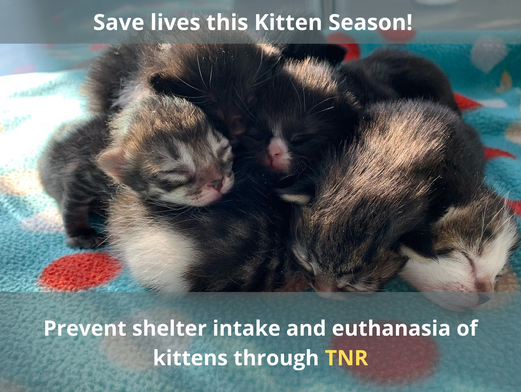|
Kitten Season is upon us again, that time of year when many people will stumble upon a litter of tiny babies – in backyards, under cars, behind restaurants. What can we cat lovers do to prevent this boom in kitten population, and the suffering it causes for cats in general in shelters and on the streets? We’re talking about TNR! It may seem like a shelter is a better place for orphaned kittens than the street, but the unfortunate truth is that newborn kittens may not survive in either environment. Kittens require constant care for at least the first four weeks of their lives. They require a mother or caregiver to keep them warm because they can’t regulate their own body temperature, feed them every two hours, and stimulate them to go to the bathroom. Municipal and other large shelters do not have the resources to provide such care and are therefore compelled to euthanize young kittens. Some shelter staff reach out to local rescues, asking them to take on a litter, but rescues too have resource limitations and can only take in so many litters at a time.
The true solution for this tragic situation is to end the problem through TNR; TNR prevents community cats from creating new litters. Additionally, TNR saves the lives of the adult cats by keeping them from being impounded at shelters, which euthanize unsocialized cats because they cannot be adopted out. TNR is Plan A, but it will be a very long time before every community cat in the U.S. (and around the world) is fixed. Despite our best efforts, outdoor litters happen and that is when cat welfare advocates turn to Plan B – doing everything possible to keep young kittens out of the shelter system. A newborn’s best chance is with the mother. Not every litter found outdoors has been abandoned. In fact, the opposite is true and usually the mother cat is nearby and will return shortly. If the kittens look clean, generally healthy, and are in a safe location, leave them be and return after a couple of hours to make sure mom’s returned. Once the kittens are older and eating on their own, mama can be TNR’d and they can be brought indoors. If a litter or individual kitten has truly been abandoned, being fostered is the only way they will survive. It is tough but rewarding work and ACR has resources that can help you. Visit www.saveac at.org/feral-kittens.html for articles about how to tell if kittens have been abandoned and how to care for them.
1 Comment
Kimberly Hiscock
5/28/2023 12:13:08 pm
States should pay for FREE CLINICS to spay and neutering ALL CATS!!
Reply
Leave a Reply. |
Details
AuthorAlley Cat Rescue is leading in the way in promoting humane and compassionate care for ALL cats. Archives
June 2024
Categories
All
|

 RSS Feed
RSS Feed